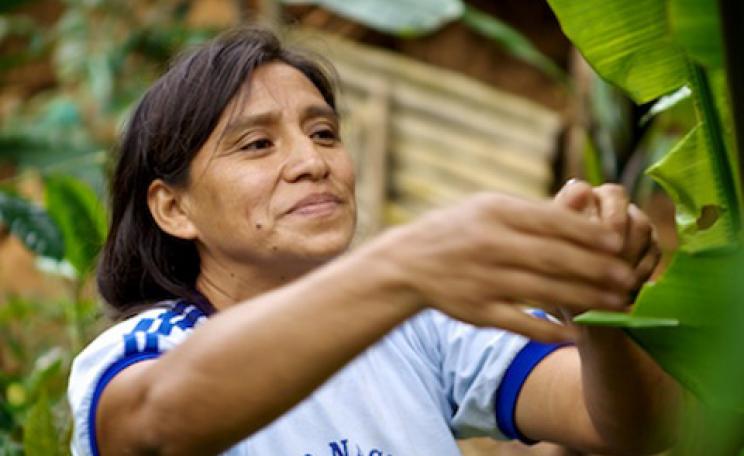During a one-day course for beginner gardeners, I learned how to identify different types of soil, sifted leaf mould to prepare it for use as compost, got my hands properly dirty planting chard and broccoli seedlings in tiny tubs, saw how raised beds can be organised into a relatively small space and tasted a variety of salad leaves and herbs – including sweet woodruff, giant red mustard, sorrel, chervil, wild garlic leaves, purple wildfl ower pansy, chicory, ruby chard, salad burnet and more – with a view to choosing favourites to grow at home.
From organic gardening principles and garden design to planting and weeding techniques, the theoretical aspect of the course, organised by Growing Communities in Hackney, one of London’s most vibrant community-supported agriculture networks, was thoroughly brought to life. Not only that, but I felt such a tremendous boost meeting my fellow growers that, three weeks on, I have spent more time in my back garden than in the previous two years. Other ‘newbie’ gardeners on the course included two people representing a community food-growing project on a London estate, a guy looking to improve the back yard of his new house and a woman curious about where the vegetables in her veg box came from.
Information can be gleaned from many sources – books and websites offering gardening advice abound – but if you are anything like me, looking to take a stab at gardening but with little more than growing a couple houseplants as your sum total experience, then I recommend a gardening course to help you take the leap. It’s the perfect answer to the somewhat tricky question, ‘Where do I start?’
The idea is that, just as with other practical skills such as sewing, breadmaking or cooking, you learn best in a hands-on environment, hearing and seeing direct from those with more experience.
Growing your own food is about helping to rebuild a sustainable food network and wresting control over what we eat from supermarkets and food conglomerates. Yes, it’s time-consuming, but for those of us with busy lives it is a step outside the ‘quick-fix’ mentality that has become so ubiquitous and seductive. Growing your own food is slowly and meaningfully rewarding.
Growing Communities provides nearly 500 North Londoners with a weekly fruit and veg box. Head grower Ru Litherland says the network aims to organise more such courses on its own. The one I attended was part of a joint initiative of the Soil Association and the Daylesford Foundation, which promotes sustainable, organic farming.
The Organic Farm School, as the initiative is known, will include 300 courses over the next two years (see box, below left) and is just one way to tap into the growing movement for organic gardening and food cultivation that is blossoming in the UK, particularly in urban areas.
Ru has been with Growing Communities for six years and says that interest in growingyour-own has increased phenomenally over the past two to three years.
‘Teaching food-growing is inspiring as it gives me a chance to step back and return to the perspective of someone who is coming to it fresh with lots of enthusiasm,’ he says. That said, there is now more demand for foodgrowing courses than there are teachers, and Growing Communities is looking at ways to assist in training programmes to expand the pool of teachers available.
With the Organic Farm School, the Soil Association aims to reach more than 3,000 individuals, and offers, ‘a chance to rediscover the precious knowledge of our grandparents’.
‘As an urban child who went into farming, I know first hand the importance of learning these skills direct from the practitioners themselves,’ says Patrick Holden, director of the Soil Association. ‘Having attended the first hen-keeping day at Daylesford I urge everyone to try one of these courses for themselves – these are essential skills for a more sustainable future.’
It is estimated that a quarter of the British population is planning on growing their own fruit and vegetables this year. With spinach, lettuce, tomatoes, parsley, basil, sorrel and French beans now growing steadily in my backyard, I can now proudly count myself among this new growing generation.
Some top tips for ‘thrifty gardening’
GARDENING is something you do, not something you buy. You don’t have to spend money to have a great garden. Slow gardening, like slow food, is taking time to savour. It’s the process, not the sudden transformation, that matters.
PRACTISE SCRAP CRAFT. Scrap craft is when you reuse or recycle unwanted items into something useful. It starts with ‘I wonder if I…’ and the end result is all sorts of cool stuff for the garden. Floorboards turn into compost bins, a chest of drawers becomes your new container garden, someone’s unwanted furniture your new patio table.
NO-GARDEN GARDENING. Containers laugh in the face of anyone who says they can’t garden because they haven’t got space. With a few containers, you can make a garden on a balcony, fire escape or rooftop, in a concrete courtyard or in those weird, unclaimed spaces at the backs of offices. If you’re renting, containers give you the chance to indulge in gardening then take the whole thing with you when you move on.
WINE BOXES are great for growing things such as salad crops, radishes, spring onions, Oriental greens, tomatoes and herbs. The best place to get them is from high-end wine merchants. Another good source is old drawers. With both, you’ll need to weatherproof (by using three coats of Danish oil) and create drainage holes in the bottom.
LARGE FOOD TINS make brilliant growing containers. Among my favourites are the big square ones containing bulk-cured olives, which could be sourced from a market stall that sells olives. Or try asking restaurants for ghee or oil tins. You’ll have to cut the top off and for the best drainage drill holes around the sides near the bottom of the tin, rather than through the base.
POTATOES grow so easily in containers that I’ve almost given up growing them in the ground. I bought five very large pots (the size of dustbins, another alternative) from a pound store and grow a summer supply with virtually no effort. Spuds will grow equally as well in old compost or mulch bags. These can be disguised with hessian sacks.
Growing courses
THE SOIL ASSOCIATION
www.soilassociation.org/organicfarmschool
Courses based around growing skills, kitchen skills, smallholding skills and a range of seasonal and specialist skills throughout the year, including foraging for wild food, hedge-laying, cider-making, beekeeping, cheese-making, preserving, butchery and game preparation, seasonal cookery demos, willow weaving and drystone walling. All new Soil Association members get 25 per cent off all classes (up to £12.50).
FOOD UP FRONT
www.foodupfront.org
Membership-based organisation that supports those wanting to grow food in their unused outdoor spaces. For a £15 annual membership fee you get a starter kit and advice and support from a local ‘street rep’. South London.
PERMACULTURE ASSOCIATION
www.permaculture.org.uk
Click on ‘courses and learning’.
NATUREWISE
www.naturewise.org.uk
Permaculture courses and forest gardens. Central London and in Wales.
CAPITAL GROWTH
www.capitalgrowth.org
This London Food Link-run project aims to create 2,012 new food-growing spaces by 2012. It provides practical and financial support to communities and offers a London-wide support network.
Based on extracts from The Thrifty Gardener by Alys Fowler (Kyle Cathie Ltd, £16.99)
Matilda Lee is the Ecologist’s Consumer Affairs Editor
For ethical and sustainable suppliers of Home and Garden goods and services check out the Ecologist Green Directory here







